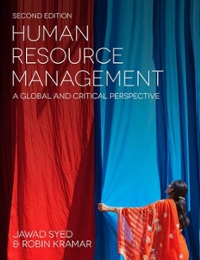Organisations across the world are currently exploring ways to integrate digital and other modern technology into organisational
Question:
Organisations across the world are currently exploring ways to integrate digital and other modern technology into organisational systems and operations. In particular, employers are interested in exploring the workforce impacts of artificial intelligence, wearable technologies and automation, among other fundamental shifts in the working world. Many companies are introducing the existing and start-up technologies to revolutionise work and job designs and processes (HRM Asia, 2016). The correlation between new technology and work can be identified in many different forms. Academics have, however, pinpointed three specific areas in which HRM practices are directly affected (Millward and Stevens, 1986):
- Advanced technology change: new plant machinery and equipment that has incorporated microprocessor technology.
- Conventional technological change: machinery and equipment not aided by microprocessor technology.
- Organisational change: substantial changes in work organisations not involving new plant, machinery or equipment (Bratton and Gold, 2007).
Across many workplaces, micro-processor technology plays an active role: in 1998, 87 per cent of manufacturing workplaces in the UK used micro-processor-based technology, a large jump from 44 per cent in 1984 (Bratton and Gold, 2007). This reflects how great an influence the technological context may have on designing HRM. Entire organisations are administered based on their information systems. In addition, manufacturing process concepts are part of the technological context that are able to directly impact upon organisations. Similarly, performance enhancement and organisational restructuring have vigorously shaped business processes in order to gain a competitive advantage.
Total quality management (TQM) focuses on maximising profits by increasing service and product quality and decreasing costs (Hill, 2005). TQM and other quality management innovations such as Six Sigma are groundbreaking institutional approaches to improving organisations and are an example of how the technological context has influenced the design of HRM. However, quality management may also pose a problem for managers and organisations: although the system welcomes key aspects of quality - between suppliers and customers - it demands mutual commitment from every party involved in the organisation and requires rigorous implementation and corporate governance, which may cause a hegemonic conflict between top and mid-level management and the workforce whom they direct.
Questions
1 Do technological advances always have positive implications for employees in organisations?
2 What role can HRM play in coping with changes in the technological context of an organisation?
Step by Step Answer:

Human Resource Management A Global And Critical Perspective
ISBN: 9781137521620
2nd Edition
Authors: Jawad Syed, J; Kramar Syed, Robin Kramar





